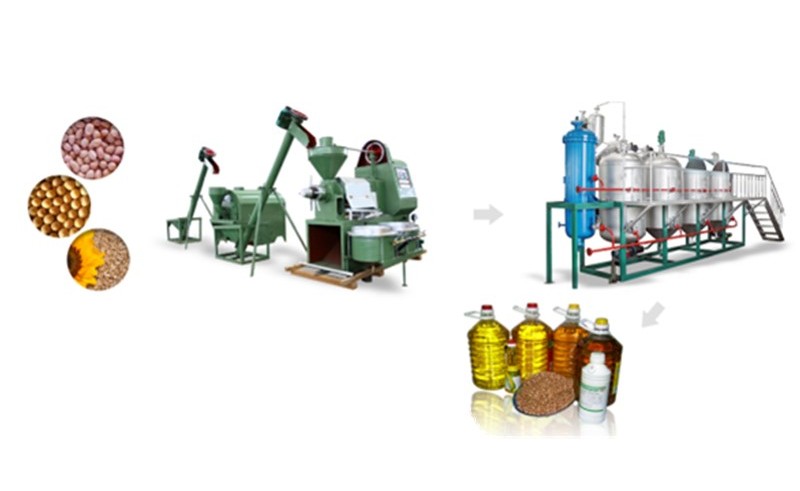What are the stages of oil refining?
Edible oil is the most basic ingredient in modern kitchens. Most of the delicacies in our daily diet cannot be separated from the help of edible oil. Nowadays, there are many types of edible oil. With the improvement of the quality of life, people are more concerned about edible oil. The requirements have become more stringent, and health, high nutrition, and variety have become the key to selection.
In order to meet this demand of the public, major manufacturers have begun to improve the quality standards of edible oil.
It is well known that edible oil is obtained through refining. If you want to obtain higher quality oil, you must make the oil refining technology more advanced. The selection of high-quality oil refining equipment has become the key for manufacturers to improve quality.
The technological level of oil refining equipment will directly affect the quality of edible oil. Do you know the steps of oil refining?

What are the stages of oil refining?
Professional technical articles in the top three oil refining production lines in sales in 2021 show that edible oil is an indispensable part of cooking, but many people do not know that different fats and oils have different processing methods. Oil refining requires the use of professional oil refining equipment.
The oil refining equipment is specially used for degumming, dephosphorization, drying, dehydration, decolorization, deacidification, deodorization, dewaxing and other physical treatments after pressing or leaching.
So as to meet the edible standards. The refined oil has very high quality standards.
The specific oil refining steps are: oil crushing-chemical leaching-high temperature separation-high temperature refining (degumming, deacidification, deacidification)
Color, deodorization, dewaxing)-add preservatives-refined oil
1. Leaching process
The leaching process is to crush the oil, fully soak the oil with a chemical solvent to extract the oil, and then separate the solvent oil by distillation to obtain the hair oil. The refining and deodorization of the oil can remove the unpleasant odor of the oil and some toxic substances.

2. Degumming
In our memory, the food when we were young always seemed to be dark, and it looked dirty and affected the appetite. This is because the old economy and the backward technology made everyone use crude oil. The crude oil has a high content of phospholipids. If it is not heated for a while, the foam on the surface of the oil will not dissipate, the oil has a heavy peculiar smell, the fried dishes are unpalatable, and the dishes are unsightly. If the heating time is long and the temperature is too high, it will smoke and generate free radicals. Therefore, it is very necessary to remove the peptic impurities in the crude oil such as phospholipids and some proteins.
2. Deacidification
Crude oil contains more than 0.5% of free fatty acids, which affects the stability and flavor of the oil. Free fatty acids have a sour taste, are sensitive to oxygen, and accelerate the oxidative rancidity of oils. At the same time, the higher the free fatty acid content in the oil, the lower the smoke point of the oil. Generally, the fuming temperature of fresh oil is 220-230℃. When the free fatty acid content reaches 0.6%, the fuming temperature of the oil drops to 148℃, so it is necessary to remove the free fatty acids in the crude oil.
3. Decolorization
Crude oil contains chlorophyll, carotenoids and other pigments. Chlorophyll is a photosensitizer, which easily absorbs light and affects the stability of oils. Using adsorbents to remove pigments can increase the oil's chemical ability, and the color of the oil after decolorization will become lighter.
4. Deodorization
Crude oil is easily oxidized and generates odorous oil oxides. For example, crude rapeseed oil has odor, and deodorization is to remove odor.
Crude oil is refined through oil, the oil quality is improved, the color becomes lighter, the smoke point is high, it is not easy to smoke and bubble during cooking, the flavor is improved, the color of the fried dishes is beautiful, and it is not easy to deteriorate.

The above is the refining steps of edible oil.
Because the types of oils and the effects to be achieved are different, the refining process will also be different. Nowadays, the development of science and technology promotes the development of the food processing industry, and we want to refine high-quality edibles. For oil, the use of Refining oil production line has become the consensus of manufacturers.
The food machinery developed by our company has a very high sales volume on the market.
With customers all over the world, and the equipment produced has helped countless manufacturers improve their economic benefits. Our Refining oil production line has reached the world's leading level. The entire production line has a very high quality, long use time, high oil yield, and the oil produced is clear in color, and does not bubble or smoke during cooking. Praised by customers.
Improving the quality and yield of edible oil is the key for manufacturers to increase their profits. It is very necessary to use high-quality equipment. If you need it, please contact us and we will serve you wholeheartedly!